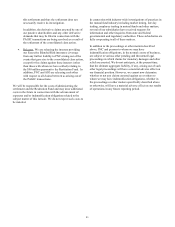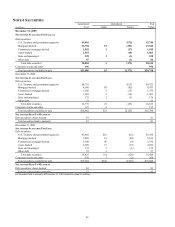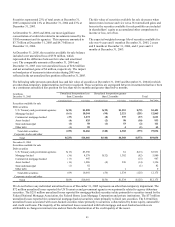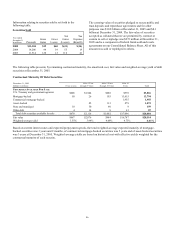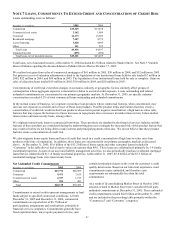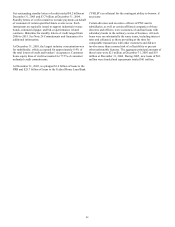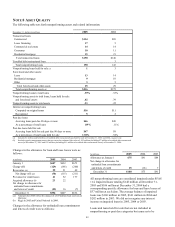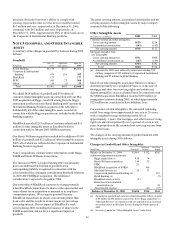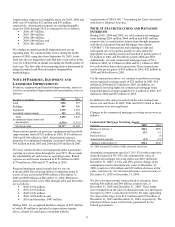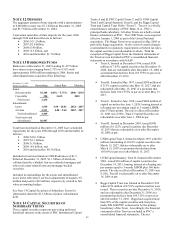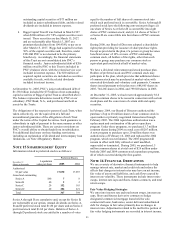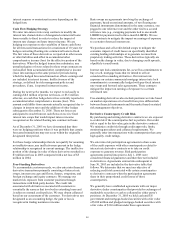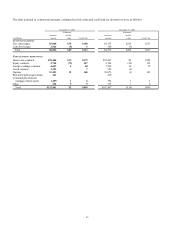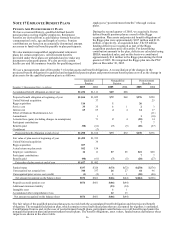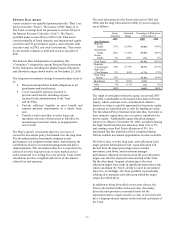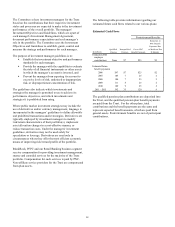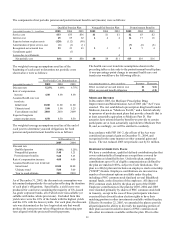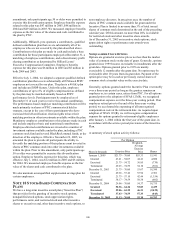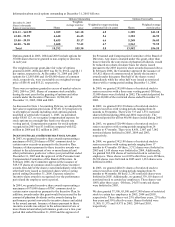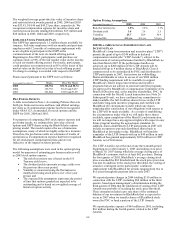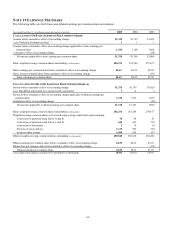PNC Bank 2005 Annual Report Download - page 93
Download and view the complete annual report
Please find page 93 of the 2005 PNC Bank annual report below. You can navigate through the pages in the report by either clicking on the pages listed below, or by using the keyword search tool below to find specific information within the annual report.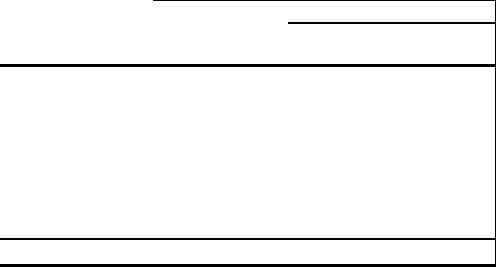
93
outstanding capital securities of $73 million are
included as junior subordinated debt, and the related
dividends are included in interest expense.
• Riggs Capital Trust II was formed in March 1997
when $200 million of 8 7/8% capital securities were
issued. These securities are due March 15, 2027,
and are redeemable after March 15, 2007 at a
premium that declines from 104.438% to par on or
after March 15, 2017. Riggs had acquired less than
50% of the capital securities and, therefore, under
FIN 46R PNC is not deemed to be the primary
beneficiary. Accordingly, the financial statements
of this Trust are not consolidated into PNC’ s
financial results. Junior subordinated debt of $206
million owed by PNC to this Trust is included in
PNC’ s balance sheet, with the related service cost
included in interest expense. The $50 million of
acquired capital securities are included as securities
available for sale, with the related dividends
included in interest income.
At December 31, 2005, PNC’ s junior subordinated debt of
$1.538 billion included the $73 million of net outstanding
capital securities of Riggs Capital Trust as described above.
The balance represents debentures issued by PNC or our
subsidiary, PNC Bank, N.A., and purchased and held as
assets by the Trusts.
The obligations of the respective parent of each Trust, when
taken collectively, are the equivalent of a full and
unconditional guarantee of the obligations of such Trust
under the terms of the Capital Securities. Such guarantee is
subordinate in right of payment in the same manner as other
junior subordinated debt. There are certain restrictions on
PNC’ s overall ability to obtain funds from its subsidiaries.
For additional disclosure on these funding restrictions,
including an explanation of dividend and intercompany loan
limitations, see Note 4 Regulatory Matters.
NOTE 15 SHAREHOLDERS’ EQUITY
Information related to preferred stock is as follows:
Preferred Shares
December 31
Shares in thousands
Liquidation
value per share 2005 2004
Authorized
$1 par value 17,030 17,057
Issued and outstanding
Series A $40 7 8
Series B 40 2 2
Series C 20 152 163
Series D 20 206 221
Total 367 394
Series A through D are cumulative and, except for Series B,
are redeemable at our option. Annual dividends on Series A,
B and D preferred stock total $1.80 per share and on Series C
preferred stock total $1.60 per share. Holders of Series A
through D preferred stock are entitled to a number of votes
equal to the number of full shares of common stock into
which such preferred stock is convertible. Series A through D
preferred stock have the following conversion privileges: (i)
one share of Series A or Series B is convertible into eight
shares of PNC common stock; and (ii) 2.4 shares of Series C
or Series D are convertible into four shares of PNC common
stock.
During 2000, our Board of Directors adopted a shareholder
rights plan providing for issuance of share purchase rights.
Except as provided in the plan, if a person or group becomes
beneficial owner of 10% or more of PNC outstanding
common stock, all holders of the rights, other than such
person or group, may purchase our common stock or
equivalent preferred stock at half of market value.
We have a dividend reinvestment and stock purchase plan.
Holders of preferred stock and PNC common stock may
participate in the plan, which provides that additional shares
of common stock may be purchased at market value with
reinvested dividends and voluntary cash payments. Common
shares issued pursuant to this plan were: 688,665 shares in
2005, 744,266 shares in 2004, and 799,820 shares in 2003.
At December 31, 2005, we had reserved approximately 38.6
million common shares to be issued in connection with certain
stock plans and the conversion of certain debt and equity
securities.
In February 2004, our Board of Directors authorized the
purchase of up to 20 million shares of our common stock in
open market or privately negotiated transactions through
February 2005. The 2004 repurchase authorization was a
replacement and continuation of the prior repurchase
program. Under these programs, we purchased 3.7 million
common shares during 2004 at a total cost of $207 million.
A new program to purchase up to 20 million shares was
authorized as of February 16, 2005 and replaced the 2004
program, which was terminated. The 2005 program will
remain in effect until fully utilized or until modified,
superseded or terminated. During 2005, we purchased .5
million common shares at a total cost of $26 million under
both the 2005 and 2004 common stock repurchase programs,
all of which occurred during the first quarter.
NOTE 16 FINANCIAL DERIVATIVES
We use a variety of derivative financial instruments to help
manage interest rate, market and credit risk and reduce the
effects that changes in interest rates may have on net income,
fair value of assets and liabilities, and cash flows caused by
interest rate volatility. These instruments include interest rate
swaps, interest rate caps and floors, futures contracts, and total
return swaps.
Fair Value Hedging Strategies
We enter into interest rate and total return swaps, interest rate
caps, floors and futures derivative contracts to hedge
designated commercial mortgage loans held for sale,
commercial loans, bank notes, senior debt and subordinated
debt for changes in fair value primarily due to changes in
interest rates. Adjustments related to the ineffective portion of
fair value hedging instruments are recorded in interest income,


